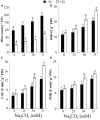Impacts of Priming with Silicon on the Growth and Tolerance of Maize Plants to Alkaline Stress
- PMID: 27014283
- PMCID: PMC4785188
- DOI: 10.3389/fpls.2016.00243
Impacts of Priming with Silicon on the Growth and Tolerance of Maize Plants to Alkaline Stress
Abstract
Silicon (Si) has been known to augment plant defense against biotic and abiotic pressures. Maize (Zea maize L.) is classified as a Si accumulator and is relatively susceptible to alkaline stress. In this study, seeds of maize were grown in pots and exposed to various concentrations of Na2CO3 (0, 25, 50, and 75 mM) with or without 1.5 mM Si in the form of sodium metasilicate Na2O3Si.5H2O for 25 days. Alkaline-stressed plants showed a decrease in growth parameters, leaf relative water content (LRWC), and the contents of photosynthetic pigments, soluble sugars, total phenols and potassium ion (K(+)), as well as potassium/sodium ion (K(+)/Na(+)) ratio. By contrast, alkaline stress increased the contents of soluble proteins, total free amino acids, proline, Na(+) and malondialdehyde (MDA), as well as the activities of superoxide dismutase (SOD), catalase (CAT), and peroxidase (POD) in stressed plants. On the other hand, application of Si by seed-priming improved growth of stressed plants, which was accompanied by the enhancement in LRWC, and levels of photosynthetic pigments, soluble sugars, soluble proteins, total free amino acids and K(+), as well as activities of SOD, CAT, and POD enzymes. Furthermore, Si supplement resulted in a decrease in the contents of proline, MDA and Na(+), which together with enhanced K(+) level led to a favorable adjustment of K(+)/Na(+) ratio, in stressed plants relative to plants treated with alkaline stress alone. Taken together, these results indicate that Si plays a pivotal role in alleviating the negative effects of alkaline stress on maize growth by improving water status, enhancing photosynthetic pigments, accumulating osmoprotectants rather than proline, activating the antioxidant machinery, and maintaining the balance of K(+)/Na(+) ratio. Thus, our findings demonstrate that seed-priming with Si is an efficient strategy that can be used to boost tolerance of maize plants to alkaline stress.
Keywords: alkaline stress; antioxidant enzymes; leaf pigments; maize; osmoprotectants; seed-priming with Si; stress mitigation.
Figures




References
-
- Abbas T., Balal R. M., Shahid M. A., Pervez M. A., Ayyub C. M., Aqueel M. A., et al. (2015). Silicon-induced alleviation of NaCl toxicity in okra (Abelmoschus esculentus) is associated with enhanced photosynthesis, osmoprotectants and antioxidant metabolism. Acta Physiol. Plant 37 1–15. 10.1007/s11738-014-1768-5 - DOI
-
- Abd-Alla M. H., El-Enany A. W., Nafady N. A., Khalaf D. M., Morsy F. M. (2014). Synergistic interaction of Rhizobium leguminosarum bv. viciae and arbuscular mycorrhizal fungi as a plant growth promoting biofertilizers for faba bean (Vicia faba L.) in alkaline soil. Microbiol. Res. 169 49–58. 10.1016/j.micres.2013.07.007 - DOI - PubMed
-
- Abdel Latef A. A. (2010). Changes of antioxidative enzymes in salinity tolerance among different wheat cultivars. Cereal Res. Commun. 38 43–55. 10.1556/CRC.38.2010.1.5 - DOI
-
- Abdel Latef A. A., Abu Alhmad M. F., Sallam M. M. (2014). Comparative study of the physiological response of two wheat cultivars to salinity stress. Assiut Univ. J. Bot. 43 55–69.
-
- Abdel Latef A. A., Chaoxing H. (2011). Effect of arbuscular mycorrhizal fungi on growth, mineral nutrition, antioxidant enzymes activity and fruit yield of tomato grown under salinity stress. Sci. Hortic. 127 228–233. 10.1016/j.scienta.2010.09.020 - DOI
LinkOut - more resources
Full Text Sources
Other Literature Sources
Miscellaneous

